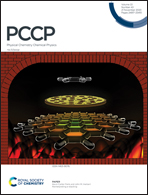A quantitative analysis of two-fold electrical conductivity relaxation behaviour in mixed proton–oxide-ion–electron conductors upon hydration†
Abstract
Electrical conductivity relaxation experiments on oxides with three mobile charge carriers, H+, O2− and e−, yield in (de-)hydration experiments kinetic parameters (diffusion coefficients and surface reaction constants). In addition, three amplitude factors are obtained, but they have not been given further consideration because quantitative expressions for their forms are lacking. In this study, the forms of the amplitude factors are derived for a diffusion-limited and a surface-reaction-limited case and a mixed case. In order to demonstrate the benefits of the approach, the electrical conductivity relaxation behaviour of lanthanum tungstate (La5.4WO11.1, LaWO54) was investigated experimentally over the temperature range 923 ≤ T/K ≤ 1223. A switch from two-fold non-monotonic relaxation behaviour at high temperatures to two-fold monotonic behaviour at low temperatures upon hydration was observed. The switch in sign of the fast kinetics' amplitude factor can be assigned to the electrochemical mobility of protons surpassing the electron–hole mobility with decreasing temperature.



 Please wait while we load your content...
Please wait while we load your content...